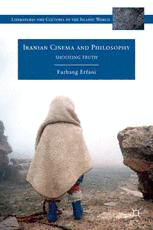
Iranian Cinema and Philosophy: Shooting Truth PDF
Preview Iranian Cinema and Philosophy: Shooting Truth
Iranian Cinema and Philosophy Literatures and Cultures of the Islamic World Edited by Hamid Dabashi Hamid Dabashi is Hagop Kevorkian Professor of Iranian Studies and Comparative Literature at Columbia University. Hamid chaired the Department of Middle East and Asian Languages and Cultures from 2000 to 2005 and was a founding member of the Institute for Comparative Literature and Society. His most recent books include Islamic Liberation Theology: Resisting the Empire; Makhmalbaf at Large: The Making of a Rebel Filmmaker; Iran: A People Interrupted; and an edited volume, Dreams of a Nation: On Palestinian Cinema. Published by Palgrave Macmillan: New Literature and Philosophy of the Middle East: The Chaotic Imagination By Jason Bahbak Mohaghegh Literature, Gender, and Nation-B uilding in Nineteenth-C entury Egypt: The Life and Works of `A’isha Taymur By Mervat F. Hatem Islam in the Eastern African Novel By Emad Mirmotahari Urban Space in Contemporary Egyptian Literature: Portraits of Cairo By Mara Naaman Poetics and Politics of the Shāhnāmeh, Iran’s National Epic By Mahmoud Omidsalar Iranian Cinema and Philosophy: Shooting Truth By Farhang Erfani Gender, Sex, and the City: Urdu Rekhtī Poetry, 1780–1870 (forthcoming) By Ruth Vanita Egyptian Colloquial Poetry in the Modern Arabic Canon: New Readings of Shicr al-cAmmiyya (forthcoming) By Noha M. Radwan Islam, Migrancy, and Hospitality in Europe (forthcoming) By Meyda Yeğenoğlu Global Perspectives on Orhan Pamuk: Existentialism and Politics (forthcoming) Edited by Mehanz M. Afridi and David M. Buyze Iranian Cinema and Philosophy Shooting Truth Farhang Erfani iranian cinema and philosophy Copyright © Farhang Erfani, 2012. Softcover reprint of the hardcover 1st edition 2012 978-0-230-33911-8 All rights reserved. First published in 2012 by PALGRAVE MACMILLAN® in the United States— a division of St. Martin’s Press LLC, 175 Fifth Avenue, New York, NY 10010. Where this book is distributed in the UK, Europe, and the rest of the world, this is by Palgrave Macmillan, a division of Macmillan Publishers Limited, registered in England, company number 785998, of Houndmills, Basingstoke, Hampshire RG21 6XS. Palgrave Macmillan is the global academic imprint of the above companies and has companies and representatives throughout the world. Palgrave® and Macmillan® are registered trademarks in the United States, the United Kingdom, Europe and other countries. ISBN 978-1-349-34215-0 ISBN 978-1-137-01292-0 (eBook) DOI 10.1057/9781137012920 Library of Congress Cataloging-in-Publication Data Erfani, Farhang, 1975– Iranian cinema and philosophy : shooting truth / Farhang Erfani. p. cm. — (Literatures and cultures of the Islamic world) Includes bibliographical references. ISBN 978-1-349-34215-0 1. Motion pictures—Iran. 2. Motion pictures—Philosophy. I. Title. PN1993.5.I846E74 2011 791.430955—dc23 2011023355 A catalogue record of the book is available from the British Library. Design by Scribe Inc. First edition: January 2012 10 9 8 7 6 5 4 3 2 1 To my Lily This page intentionally left blank Contents Note from the Editor ix Acknowledgments xi Introduction 1 1 How Orphans Believe: Deleuze, National Cinema, and Majidi’s The Color of Paradise 13 2 “What Are Filmmakers for in Needy Times?” On Heidegger and Kiarostami’s Taste of Cherry 39 3 Committed Perception: Merleau- Ponty and Children of Heaven 69 4 Regarding You: Lacanian Gaze and Ethics in Kiarostami’s Close- Up 87 5 Stolen Jouissance: Lacan, Feminism, and Meshkini’s The Day I Became a Woman 115 6 Deafening Silence: Bahman Ghobadi’s Turtles Can Fly and Marginal Politics 157 Notes 193 References 205 Index 223 This page intentionally left blank Note from the Editor The Islamic world is home to a vast body of literary production in multiple languages over the last 1,400 years. To be sure, long before the advent of Islam, multiple sites of significant literary and cultural productions existed from India to Iran to the Fertile Crescent to North Africa. After the advent of Islam in the mid- seventh century CE, Arabic, Persian, Urdu, and Turkish authors in par- ticular produced some of the most glorious manifestations of world literature. From prose to poetry, modern to medieval, elitist to popular, oral to literary, this body of literature is in much need of a wide range of renewed scholarly investigation and lucid presentation. The purpose of this series is to take advantage of the most recent advances in literary studies, textual hermeneutics, critical theory, feminism, postcolonial- ism, and comparative literature to bring the spectrum of literatures and cultures of the Islamic world to a wider audience and appreciation. Usually the study of these literatures and cultures is divided between classical and modern periods. A central objective of this series is to cross over this artificial and inapplicable bifurcation and abandon the anxiety of periodization altogether. Much of what we understand today from this rich body of literary and cultural production is still under the influence of old-f ashioned Orientalism or post–W orld War II area studies perspectives. Our hope is to bring together a body of scholarship that connects the vast arena of literary and cultural production in the Islamic world without the prejudices of outmoded perspectives. Toward this end, we are committed to pathbreaking strategies of reading that collectively renew our awareness of the literary cosmopolitanism and cultural criticism in which these works of creative imagination were conceived in the first place. — Hamid Dabashi
